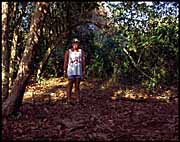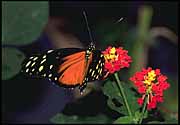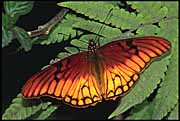Insects
by
Christopher Baker
Home : Travel : Costa Rica : CR Handbook : One Article
The long history of the rainforest has enabled countless butterflies,
moths, ants, termites, wasps, bees, and other tropical insects to evolve in
astounding profusion. There are many thousands of ant species alone. Corcovado
National Park alone has at least 220 species of breeding butterflies, plus
others that simply pass through. And there are so many species of beetles and
grasshoppers that no one knows the true numbers. Many, many thousands of insect
species still await identification.
The most brilliantly painted insects are the butterflies and moths,
some quite tiny and obscure, others true giants of the insect kingdom,
dazzlingly crowned in gold and jewel-like colors. In Guanacaste, hundreds of
species of bees, moth larvae, and tiger beetles make an appearance in the early
dry season. When the first rains come, lightbulbs are often deluged with adult
moths, beetles, and other insects newly emerged from their pupae. That's the
time, too, that many species of butterfly migrate from the deciduous lowland
forests to highland sites.
Many insect species are too small to see. The hummingbird flower
mite, for example, barely half a millimeter long, is so small it can hitch
rides from flower to flower inside the nostrils of hummingbirds. Other insects
you may detect by their sound. Male wood crickets, for example, produce a very
loud noise by rubbing together the overlapping edges of their wing cases.
There are many exotic-looking species that you can immediately
recognize. Guanacaste stick insects are easily spotted at night on low shrubs.
The three-inch rhinoceros beetle has an unmistakable long, upward-curving horn
on its head. And the number of spiders ornamented with showy colors is
remarkable. Some even double themselves up at the base of leafstalks, so as to
resemble flowerbuds, and thus deceive the insects on which they prey.
Of course, a host of unfriendly bugs also exist in great numbers:
chiggers, wasps and bees (including aggressive African bees), ticks,
mosquitoes, and the famous "no-see-ums." All five insects can inflict
irritating bites on humans (see "Health Care" in the "Out and About"
chapter).
ANTS
Leaf-cutting Ants
 There's something endearing about the leaf-cutting ant (Atta
cephalotes), a mushroom-farming insect found in lowland forests throughout
Costa Rica, carrying upright in its jaws a circular green shard scissored from
the leaves of a plant. At some stage in your travels you're bound to come
across an endless troop of "media" workers hauling their cargo along jungle
pathways as immaculately cleaned of debris as any swept doorstep.
There's something endearing about the leaf-cutting ant (Atta
cephalotes), a mushroom-farming insect found in lowland forests throughout
Costa Rica, carrying upright in its jaws a circular green shard scissored from
the leaves of a plant. At some stage in your travels you're bound to come
across an endless troop of "media" workers hauling their cargo along jungle
pathways as immaculately cleaned of debris as any swept doorstep.
The nests are built below ground, sometimes extending over an area
of 200 square meters, with galleries to a depth of six meters. Large nests
provide a home for up to five million insects. (All ant societies are composed
entirely of females; males exist only to fertilize the queen and then die. And
only the queen, who may boast a thousand times the body weight of a minor
worker, is fertile. Hence, all other ants in the colony are her daughters.)
They set off from their nests, day and night, in long columns to demolish
trees, removing every shoot, leaf, and stem section by tiny section and
transporting them back to their underground chambers.
They don't eat this material. Instead, they chew it up to form a
compost on which they cultivate a nutritional breadlike fungus whose tiny white
fruiting bodies provide them with food. The species has evolved different
physical castes, each specializing in its own social tasks. Most of the workers
are tiny minors ("minimas"), which tend the nest. The cutting and carrying is
performed by intermediate-size workers ("medias"), guarded by ferocious-looking
"majors" about three-quarters of an inch long.
Army Ants
The most terrifying ants of all are the army ants, which march through the
forest with the sole intent of turning small creatures into skeletons in a few
minutes. They produce a faint hissing sound and distinct ant-army odor. They're
like a wolf pack, but with tens of thousands of miniature beasts of prey which
merge and unite to form one great living creature.
Hollywood images of mammals and even humans fleeing madly before
them are mostly imagination run wild. In truth, while the ants advance across
the forest floor driving small creatures in front of them, humans and other
large creatures can simply step aside and watch the column pass by--this can
take several hours. Even when the ants raid human habitations, people can
simply clear out with their foodstock while the ants clean out the cockroaches
and other vermin as thoroughly as any exterminator might.
The army ants' jaws are so powerful that Indians once used them to
suture wounds: the tenacious insect was held over a wound and its body squeezed
so that its jaws instinctively shut, clamping the flesh together. The body was
then pinched off.
Larvae carried by workers produce pheromones which stimulate the
army to keep on the move. When the larvae begin to pupate and no longer exude
their chemical messages, the ants bivouac in a vast ball in a hollow. They
actually cling to one another and make a nest of their bodies, complete with
passageways and chambers where the eggs are deposited. Once the queen lays her
eggs and these hatch as larvae, a new generation of workers and soldiers
synchronistically emerges from the stored pupae. The larvae begin to secrete
their characteristic pheromone, and the army is again stimulated to march off
and terrorize the bush.
BUTTERFLIES
 With nearly 1,000 identified species (approximately 10% of the world
total), Costa Rica is a lepidopterist's paradise. You can barely stand still
for one minute without checking off a dozen dazzling species: metallic gold
riondinidae; delicate black-winged heliconius splashed with bright red and
yellow; orange-striped paracaidas; and the deep neon-blue flash of morphos
fluttering and diving in a ballet of subaqueous color. The marvelously
intricate wing patterns are statements of identity, so that individuals may
recognize those with whom mating may be fertile.
With nearly 1,000 identified species (approximately 10% of the world
total), Costa Rica is a lepidopterist's paradise. You can barely stand still
for one minute without checking off a dozen dazzling species: metallic gold
riondinidae; delicate black-winged heliconius splashed with bright red and
yellow; orange-striped paracaidas; and the deep neon-blue flash of morphos
fluttering and diving in a ballet of subaqueous color. The marvelously
intricate wing patterns are statements of identity, so that individuals may
recognize those with whom mating may be fertile.
Not all this elaboration has a solely sexual connotation. Some
butterflies are ornately colored to keep predators at bay. The bright white
stripes against black on the zebra butterfly (like other members of the
Heliconid family), for example, tell birds that the butterfly tastes acrid.
There are even perfectly tasty butterfly species which mimic the Heliconid's
colors, tricking predators to disdain them. Others use their colors as
camouflage so that at rest they blend in with the green or brown leaves or look
like the scaly bark of a tree. Among the most intriguing, however, are the
owl-eye butterflies, with their five-inch wingspans and startling eye spots.
The dull, blue-gray Caligo memnon, the cream owl butterfly, is the most
spectacular of the owl-eyes: the underside of its wings is mottled to look like
feathers and boasts two large yellow-and-black "eyes" on the hind wing, which
it displays when disturbed.
 The best time to see butterflies is in the morning, when most
species are active. A few are active at dawn and dusk, and there is even one
species that is active by night. In general, butterfly populations are most
dense in June and July, corresponding with the onset of the rainy season on the
Pacific side. Butterfly migrations are also common. Like birds,
higher-elevation species migrate up and down the mountains with changes in
local weather. The most amazing migration--unsurpassed by any other insect in
the Neotropics--is that of the kitelike uranidae (this black and iridescent
green species is actually a moth that mimics the swallowtail butterfly), in
which millions of individuals pass through Costa Rica heading south from
Honduras to Colombia.
The best time to see butterflies is in the morning, when most
species are active. A few are active at dawn and dusk, and there is even one
species that is active by night. In general, butterfly populations are most
dense in June and July, corresponding with the onset of the rainy season on the
Pacific side. Butterfly migrations are also common. Like birds,
higher-elevation species migrate up and down the mountains with changes in
local weather. The most amazing migration--unsurpassed by any other insect in
the Neotropics--is that of the kitelike uranidae (this black and iridescent
green species is actually a moth that mimics the swallowtail butterfly), in
which millions of individuals pass through Costa Rica heading south from
Honduras to Colombia.
The best places to see butterflies in all stages are the
Butterfly Farm (see "La Guácima" in the "Central Highlands"
chapter), at La Guácima; Spirogyra (tel. 222-2937), near the El
Pueblo Shopping Center in San José; Butterfly Paradise (tel.
221-2015), at San Joaquín de Flores, three km northwest of Heredia;
Wings For Education (tel. 223-0343), in Santo Domingo de Heredia; and
the Butterfly Garden at Monteverde.
Selva Verde Lodge offers butterfly-study workshops (1-9
days) at La Selva Biological Station and Los Inocentes in Guanacaste. For
information, contact Costa Rican Lodges (3540 NW 13th St., Gainesville,
FL 32609; tel. 904-373-7118 or 800-451-3711, fax 904-371-3710). Wings for
the Earth is a nonprofit organization dedicated to supporting
community-based tropical butterfly and insect-rearing projects worldwide. The
group works closely with local conservation organizations in Colombia, Ecuador,
and Jamaica. Contact Wings for the Earth (6341 Longcroft Dr., Oakland, CA
94611; tel. 510-531-8959, fax 510-531-6659).
philg@mit.edu
 There's something endearing about the leaf-cutting ant (Atta
cephalotes), a mushroom-farming insect found in lowland forests throughout
Costa Rica, carrying upright in its jaws a circular green shard scissored from
the leaves of a plant. At some stage in your travels you're bound to come
across an endless troop of "media" workers hauling their cargo along jungle
pathways as immaculately cleaned of debris as any swept doorstep.
There's something endearing about the leaf-cutting ant (Atta
cephalotes), a mushroom-farming insect found in lowland forests throughout
Costa Rica, carrying upright in its jaws a circular green shard scissored from
the leaves of a plant. At some stage in your travels you're bound to come
across an endless troop of "media" workers hauling their cargo along jungle
pathways as immaculately cleaned of debris as any swept doorstep. 
